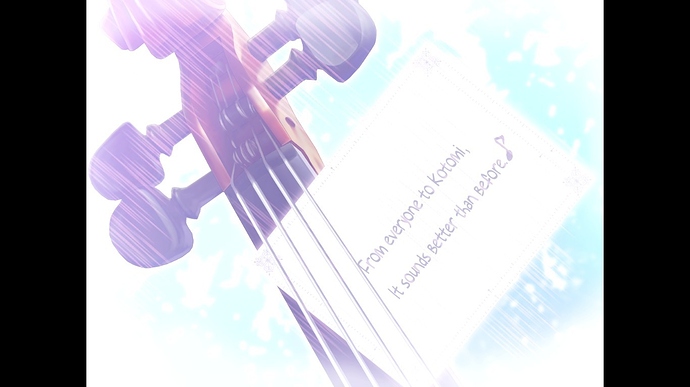Yuuichi Suzumoto is a master storyteller. I know that much from Planetarian, but I never expected so much of the same personality and style of writing to carry over to this route.
I don’t remember much about Kotomi from the anime, save some of the small liberties KyoAni did to make the route less romance-focused. To be frank, if you strip the romance from this route, it bears an almost uncanny resemblance to Little Busters in terms of themes. Kotomi learning how to step outside her comfort zone and learn how to be friends with other people is a major part of the story, and I wouldn’t be surprised if Maeda was so impressed by how it turned out that he made a whole VN like it. 
But Kotomi’s route extends far beyond the themes of friendship and family, stretching into themes that by now exemplify Suzumoto’s work. Religious parallels are all over the place, but their execution is far from haphazard. In actuality, it’s almost perfect, and it contains a lot of what I value a great deal in literature today: truth. Suzumoto teaches us through subtle, natural language that knowledge is a powerful and helpful tool, but sometimes the truth that eludes even the most learned scholars is simpler than we think. In the same vein, there is as much beauty in simplicity as there is in complexity. It’s something that people tend to rediscover as they strive to achieve personal goals, feeling immense pressure to strive for something greater and of higher understanding when the answer was there all along.
Kotomi’s personal dilemma lies in her conflicting goals; she desires to achieve the same lofty academic understanding and reputation her parents had, while at the same time striving to do what she really wants to do. We see that her desire to atone for destroying her parents’ legacy is a far stronger motive, but over the course of the story she grows attached to the friends she made and the talents she built. It’s real character development, something quite difficult to come across in a lot of Key routes.
If anything, though, the biggest reason I like this route is how TomoyaYou develops as a character. As he grows closer to Kotomi, he starts to value school, the Drama Club, and of course, the town just a little bit more. He starts coming to school on time and paying attention a bit in classes, even if it’s just to meet Kotomi in the library at lunchtime. He grows attached to the Drama Club and its antics, even if it’s just to help Kotomi make friends and flex her creative muscles. He throws away his savings to fix her yard up, just to get Kotomi to come back to school. The amount of dedication he places in her welfare is both staggering and admirable, even if it won’t carry into the other routes. 
Since I am technically going by the Kaza-sanctioned route order, this route introduces the piece ‘To the Same Heights’, a somber piano piece composed by Jun Maeda. Like a good deal of Maeda’s pieces, the emotions it carries are complex, but not in the same way a piece like Natsukage or Nagisa is. On the surface, it conveys a feeling of warmth, perhaps from the embrace of a loved one. But given the context of Kotomi’s route, I feel it conveys a feeling of warmth from knowing that even if a loved one has passed on, their warmth and presence can still be felt. It’s a beautiful piece, up there with the aforementioned pieces Maeda composed.
I’m glad I spent so much time reading this route. I don’t think it’s perfect (Kotomi’s voice actress bothers me a bit, there’s a small problem with how the ending handles the religious themes, etc.) but I still give it a five because it’s still exceptionally well-written. Granted, Yukine set the bar pretty high already, so maybe the next few routes will be going a bit downhill? Who can tell, save I seek out the truth for myself?
Now, who’s next?
…K-Kyou~?! 
EDIT (07/07/16): For the K.E.Y.:
CLANNAD had many amazing routes in it, but the one that stuck with me the most was Kotomi. It feels like the prototype of Little Busters in terms of how memorable the characters are and how entertaining yet thought-provoking the story is. Even Tomoya experiences a small bit of character development in this route, something other routes wish they could have. Themes of family, friendship and the development of oneself help carry the route, but it does something only Planetarian would ever try to accomplish. That is, it tries to answer questions that go beyond our understanding.
The inspired truth this route carries is one of the strongest points of Kotomi’s route to me. Holding on to the hope that someone benevolent as well as omnipotent is watching over us is not an easy task. Kotomi’s faith is constantly tested, and there are times when circumstances cause her faith to waver, and she becomes lost trying to redeem her mistakes. The last part of the story is magical to me because despite all that’s happened to her, someone who loves her always watched over her. It makes me sad that Yuuichi Suzumoto is no longer with Key, because I would love to see an after story for Kotomi.

